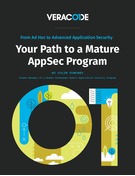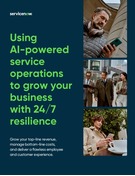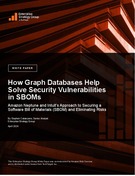Evaluating Thin-Client Security in a Changing Threat Landscape
By: Intel View more from Intel >>
Download this next:
Your path to a mature AppSec program
By: Veracode, Inc.
Type: eBook
According to a recent Verizon study, almost 40% of observed security incidents and data breaches were the direct result of a cyberattack targeting web applications – but it’s no secret that apps are often the target of today’s threats.
This e-book, Your Path to a Mature AppSec Program, provides expert guidance to help your organization modernize its AppSec approach – chapters include:
- An introduction to application security
- AppSec stages
- Steps to reach AppSec security
- & more
Download the e-book to get started.
These are also closely related to: "Evaluating Thin-Client Security in a Changing Threat Landscape"
-
Using AIOps to grow your business with 24/7 resilience
By: ServiceNow
Type: eBook
How can you ensure your existing IT services run smoothly 24/7, to help your business grow? Start by automatically remediating IT issues in hybrid environments before they impact the business. Read this guide to learn how AI-powered service operations can help you get the most out of your existing IT investments, to deliver extraordinary IT experiences for employees, boost revenue, reduce costs, speed innovation, and transform your business.
-
Enterprise Strategy Group report: Solving vulnerabilities in SBOMs
By: Amazon Web Services
Type: ESG White Paper
Software bills of material (SBOMs) are foundational to risk management and cybersecurity.
In this white paper, expert-level analysts from TechTarget’s Enterprise Strategy Group (ESG) explore the methodologies Amazon Neptune and Intuit use to secure a software bill of materials (SBOM).
Download your copy of the ESG white paper now to unlock insight into SBOM security.
Find more content like what you just read:
-
Leader’s Guide to Software Supply Chain Security
By: ReversingLabs
Type: Gartner Research Report
According to the new Gartner report, Leader’s Guide to Software Supply Chain Security, software supply chain attacks costs will rise from $46 billion in 2023 to $138 billion by 2031 (a 200% increase). Download the Gartner report to learn more.
-
Five Steps to Effective Third-Party Access Governance
By: Saviynt
Type: eBook
Attracting and retaining employees has become more complicated. Most organizations don't know how many third-party relationships they have. Saviynt Identity Cloud combines multiple identity management capabilities into a single cohesive platform to unify controls and risk management for every identity, app, and cloud across your business.
-
The Hidden Risks of Third-Party Access
By: Saviynt
Type: White Paper
How many vendors have the key to your kingdom? The sheer volume of access requests has overwhelmed Identity and Access Management (IAM) teams and made third-party access a prime attack vector. Read this eBook to learn more.
-
Webinar | Why Just Securing Human Identities Is Not Enough
By: CyberArk
Type: Webcast
If your business leverages digital technology, then securing human access is not enough - attackers will find the weak point. Don’t let it happen to you! In this session you'll learn why you need to secure both your human and machine identities, as well as the applications and workloads they access. Tune in now to learn more.
-
Best practices for comprehensive file upload security
By: Deep Instinct
Type: White Paper
Organizations accept files through their web applications to run their business. But, files being uploaded by customers could contain malware or some other risk that could hurt your business. What is scarier is that 80% of successful breaches come from zero-day attacks. Read on to learn more and don’t let malicious files stay like uninvited guests.
-
31-pg eBook: Research into top security threats, business preparedness
By: Vodafone
Type: Research Content
This cybersecurity report details how you can become a Fit for the Future (FFTF) business; organizations that take a very different approach to security challenges, resulting in increased revenue, ESG commitment, and reduced impact from cybersecurity attacks. Explore the report here.
-
Manufacturing sector guide: Top risks and cyber resilience
By: Vodafone
Type: eBook
In this eBook, you’ll learn about what issues manufacturing organizations are facing, key trends that are impacting them and how technology can help these firms build resilient supply chains against operational risks. Read the eBook.
-
Top IT security priorities: Addressing risk management and compliance
By: Dell Software
Type: eGuide
In this expert e-guide, we explore the issues of IT risk management and compliance. You'll learn about best practices for audits, the role log reviews play in monitoring IT security, how to build authentication into access management systems, and more.
-
6 ways to organize the chaos of retail technologies
By: Hughes Network Systems
Type: Blog
Retail is where groundbreaking technology and innovation converges with traditional storefronts, and experience-based customer experience. But how can you best implement the chaotic influx of retail technology? This blog explores 6 ways your organization can navigate emerging retail tech. Read on to learn more.
-
Security brief: Threats against people, apps, and infrastructure
By: Cloudflare
Type: eBook
Take a deep look at the most important trends shaping the cyber threat landscape today: AI, vulnerability exploitation, DDoS attacks, phishing, and Zero Trust. Based on the extensive data from Cloudflare’s cloud network, this security brief highlights key trends. Access the brief to learn more.
-
How USA’s largest credit union crafted a culture of resilience
By: NewRocket
Type: Case Study
As a highly regulated organization in a rapidly changing world, Navy Federal Credit Union (NFCU), the largest credit union in the United States, knew it had to be prepared for anything. In this guide, learn exactly how NFCU overcame resilience roadblocks and jump-started its resilience journey.
-
How Five Guys serves up risk management success
By: Hughes Network Systems
Type: Webcast
In this webinar, Tim Tang, the Director of Enterprise Solutions at Hughes, sits down with the Director of Risk Management and the VP of IT at global restaurant chain Five Guys Enterprises for an important discussion around the complexities of risk management. Learn more by viewing the webinar now.
-
7-Step Cybersecurity Risk Assessment Framework for Professionals
By: VikingCloud
Type: White Paper
Cybersecurity threats are on the rise, with 78% more breaches in the U.S. in 2023. This white paper outlines a 7-step risk assessment framework to help cybersecurity professionals identify critical assets, assess vulnerabilities, mitigate risks, and build cyber resilience. Read the full white paper to learn more.
-
Schools and Cybersecurity: Tips, Threats and More
By: SonicWall
Type: White Paper
Because K–12 systems usually employ fewer cybersecurity experts than other industries, they are a prime target for cybercriminals. So, how can K–12 environments improve security? For guidance, check out this 8-page white paper.
-
11 Reasons Why Utimaco GP HSMs Are The Better Choice
By: Utimaco
Type: Blog
Utimaco's General Purpose Hardware Security Modules (GP HSMs) aim to offer superior performance, security, and flexibility. With features like post-quantum readiness, multi-tenancy, and seamless integration, Utimaco's GP HSMs can equip your organization for the future of cybersecurity. Read the full blog post to learn more.
-
The Oversight Spend Insights Report - Issue #2
By: Oversight Systems
Type: eBook
This report analyzes patterns of fraud associated with missing receipts, a common early indicator of potential expense account abuse. Learn how AI can help identify these risks and protect your organization's resources. Read the full report to learn more.
-
Revolutionizing DAST with IAST: A new era in application security
By: Contrast Security
Type: White Paper
While dynamic application security testing (DAST) has been a go-to AppSec testing technique for decades, it is not without its drawbacks. This is where interactive application security testing (IAST) comes into play, building off of DAST, but analyzing apps from the inside out, rather than from the outside in. Read this white paper to learn more.
-
Doing more with less: Cost-effective application security
By: Cloudflare
Type: White Paper
While the cost of security breaches continues to increase, many security teams have found ways of achieving success with limited resources. This white paper shares real-life stories of companies that have successfully created efficiencies and cut costs in their application security strategy. Download now to discover more.
-
Next-gen Defense: Leveraging AI with Cortex XDR for Unmatched Protection
By: CBTS
Type: Product Overview
Cortex XDR delivers advanced threat prevention, detection, and response by integrating endpoint, cloud, identity, and network data. It leverages AI and machine learning to enhance visibility, triage alerts, and automate incident response. Read the full product overview now to learn how Cortex XDR can help protect your organization.
-
Practical DevSecOps : Reduce risk and go to market faster
By: Veracode, Inc.
Type: eBook
Discover how to implement a successful DevSecOps approach and secure your software development lifecycle. Learn practical steps to integrate security early, automate processes, and reduce risk. Read the full e-book to get started.
-
Emerging Trends In Security Posture Management (SPM)
By: OpenText
Type: White Paper
Explore the growing importance of security posture management (SPM) in today's digital landscape. Learn how proactive SPM can enhance cyber resilience by prioritizing risks, leveraging behavioral analytics, and automating security responses. Read the white paper to discover emerging SPM trends and use cases.
-
Quick Guide to the SOC Revolution
By: Palo Alto Networks
Type: Infographic
To discover 6 components of a reimagined SOC, and to learn how you can harness those capabilities at your own organization, tap into this infographic by Palo Alto Networks.
-
Time To Adapt: The Future of Human Risk Management (HRM)
By: CultureAI
Type: Webcast
Join Forrester's VP, Principal Analyst, Jinan Budge, and CultureAI Founder & CEO, James Moore, as they explore how quantifying and managing human risk is pivotal to the future of security.
-
Secure networking for a hybrid workforce: The journey to unified SASE
By: Aryaka
Type: White Paper
Enterprises face increased security challenges as cloud adoption and remote work grow. Read this white paper to learn how Unified SASE as a Service can modernize, optimize, and transform your network and security to provide secure, high-performance access across your hybrid workforce.
-
End-to-End Supply Chain Risk Management: Implementing Effective Strategies
By: Lumen
Type: Blog
This article can provide you with insight into effective strategies to manage end-to-end supply chain risks and how to identify and remediate third-party vulnerabilities. Additionally, you can discover how to enforce encryption practices, and implement a robust incident response plan. Read the full article to learn more.
-
Urban Myths About Secure Coding
By: Veracode, Inc.
Type: eBook
Urban myths, whether rooted in reality or fabricated entirely, have the power to change perception. Read this e-book which is designed to rectify these misconceptions by presenting six common urban myths about secure coding and giving practical guidance for how to overcome them.
-
Speed up development with static analysis security solutions
By: Veracode
Type: White Paper
Developers need security testing solutions that can keep pace with rapid, agile development processes. Traditional AppSec solutions can cause development to stall and delay the release of software. In this guide, learn how static analysis solutions can secure applications without hindering fast development.
-
The Essential Guide to MITRE ATT&CK
By: Palo Alto Networks
Type: Research Content
Discover how Palo Alto Networks' Cortex XDR performed in MITRE's 2023 cyberattack simulations versus Turla. Achieving 100% visibility, it blocked all techniques, ensuring top-quality detections. Delve into the results and uncover Cortex XDR's effectiveness in this report.
-
NewRocket Maximizing Enterprise Resilience with Visibility and Trust
By: NewRocket
Type: Webcast
If skepticism of data quality has made you hesitate making business decisions, you’re not alone: 75% of executives do not have a high level of trust in their data. One of the best ways to improve visibility and trust of your data is to unify around one platform. Watch this webinar to learn more about how you can maximize enterprise resilience.
-
Tanium for Cyber Insurance
By: Tanium
Type: Product Overview
Managing and protecting the thousands of devices that are connected to your network has never been more challenging. Cyber insurance is a key tool to mitigate the associated risks. Explore 10 steps for assessing cyber risk for cyber insurance when you download this guide.
-
The Business Value of Zscaler Data Protection
By: Zscaler
Type: Analyst Report
Businesses are racing to embrace cloud and mobility. This new study from IDC demonstrates how Zscaler Data Protection solutions ensures effective and efficient data security. Organizations using Zscaler described improving data security regardless of user location or means of access. Download the report today!
-
7 advantages of a SaaS-based application security program
By: Veracode, Inc.
Type: Resource
In this infographic, discover 7 advantages of a SaaS-based application security program vs. on-premises.
-
IDC TechBrief: Interactive Application Security Testing
By: Contrast Security
Type: White Paper
With modern application development operating at break-neck speeds, DevOps teams pressured by deadlines are often forced to compromise security for efficiency’s sake. This white paper examines the benefits of using interactive application security testing to mitigate the security risk and complexities of using DevSecOps. Read on to learn more.
-
Bitdefender GravityZone Reduce the Attack Surface and Unify Security Beyond Endpoints
By: Bitdefender
Type: Product Overview
Bitdefender GravityZone, a security platform that unifies risk management, prevention, protection and extended detection and response, has grabbed the attention of cybersecurity experts around the world. In this paper, discover why the comprehensive and highly flexible platform has won multiple awards in the past year.
-
Doing more with less: Cost-effective application security
By: Cloudflare
Type: White Paper
While the cost of security breaches continues to increase, many security teams have found ways of achieving success with limited resources. This white paper shares real-life stories of companies that have successfully created efficiencies and cut costs in their application security strategy. Download now to discover more.
-
How financial teams can mitigate, minimize & eliminate risk
By: Oversight Systems
Type: Landing Page
When every payment contains some type of risk to a company’s bottom line, it’s critical to take a proactive and effective approach to fraud protection. Browse this case study to discover more.
-
The Paved Path to Balancing Security and Innovation
By: Atlassian
Type: White Paper
Discover in this white paper how business leaders are dealing with the complexities and increased security risks resulting from remote and hybrid teams, growing cloud adoption, the macroeconomic environment, and more.
-
How transport and logistics organizations can build cyber resilient operations
By: Vodafone
Type: eBook
In this eBook, you’ll learn about what issues transport and logistics organizations are facing, key trends that are impacting the sector, and how technology can help these firms be better prepared to overcome the challenges of today and the future. Read the eBook here.
-
Cyber Executive Brief: Managing Risk Effectively
By: Trend Micro
Type: Product Overview
In this cyber executive brief, learn how you can effectively manage risk in the evolving threat landscape.
-
Eliminating your software security technology debt
By: Veracode, Inc.
Type: eBook
Discover how to quickly identify, prioritize, and fix software vulnerabilities with Veracode's AI-driven remediation. Eliminate security technology debt and deliver secure, cloud-native applications at scale. Read the e-book to learn more.
-
From Fraud Detection to Protection
By: Teleperformance
Type: White Paper
Any company that stores sensitive information is at risk for fraud. Whether it’s financial or personal data, if you have it, there is a good chance someone is trying to get at it. This problem is compounded even more with remote work and the rise of AI. All of this means it’s time to rethink your fraud prevention posture. Read on to learn more.
-
Comprehensive asset inventory for enhanced cybersecurity
By: Redjack
Type: Product Overview
Comprehensive asset inventory solution provides dynamic, real-time visibility into your connected infrastructure, helping you build cyber resilience and prioritize security efforts. Learn more in this guide.
-
The benefits of unified SASE: How to better secure user access & more
By: Aryaka
Type: Case Study
Lauridsen Group International, a global manufacturer, adopted Aryaka's Unified SASE to secure user access and filter network traffic across its 60+ locations. The solution reduced management complexity, cut costs, and enabled faster site deployments. Read the full case study to learn more.
-
Next-Gen SASE Will Score the Transformation Trifecta of Distributed Cloud, Workforce, and Edge Applications
By: Aryaka
Type: Research Content
This whitepaper examines how the shift to distributed cloud, workforce, and edge applications is transforming enterprise IT. It explores how next-gen SASE solutions can address these evolving requirements by providing flexible connectivity, robust security, and AI-driven management. Read the full whitepaper to learn more.
-
Simplify Your Migration From MPLS To SASE
By: Aryaka
Type: White Paper
As enterprises move from legacy MPLS networks, they face concerns about performance, security, and migration complexity. This whitepaper explores strategies to simplify the transition to SASE, including choosing the right platform, planning a phased migration, and leveraging expert support. Read to reduce risk and modernize your network.
-
Reduce Financial Crime and Fraud in Financial Services
By: Splunk
Type: White Paper
The Splunk Fraud and Crime Outcome Brief details how financial institutions can leverage Splunk's advanced data aggregation and machine learning capabilities to detect, investigate, and respond to financial fraud and crime.
-
Risk Management: What Security Experts Recommend
By: CyberMaxx
Type: Blog
To unlock insights about, and best practices for, threat intelligence and risk management from security experts at CyberMaxx, browse this blog.


